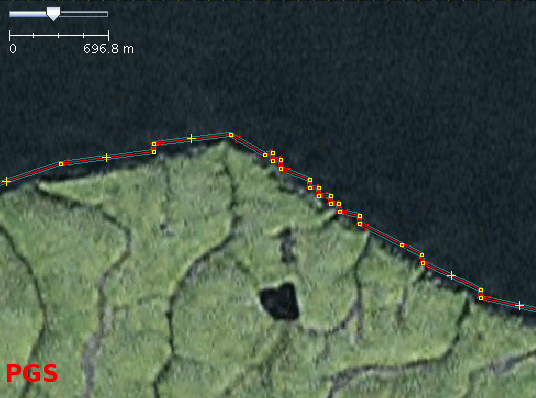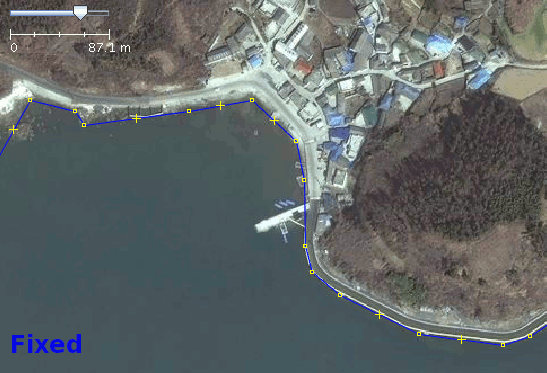Prototype Global Shoreline
The Prototype Global Shoreline (PGS) is a datasource which we have used for a lot of coastline data. The data was extracted from the public domain Landsat imagery via an automatic image recognition algorithm (Vectorisation software).
PGS coastlines are generally very crude and need fixup. Small and non-contiguous PGS riverbank fragments imported together with the coastlines may be removed.
Importing PGS data into OSM
We have a script called "Almien coastlines (PGS)" for importing this data into OSM. The import process was initially done in piecemeal on-demand fashion (started in August 2006) but it has been run over pretty much the entire planet now.
Coastlines are represented in the OSM database as ways with Tag:natural=coastline
Accuracy and other problems
With the raw PGS data you cannot determine which side is water and which side is land, and there are many gaps in the data which needed to be traced by hand. These problems have mostly been sorted out afterwards within the imported data in OpenStreetMap, using the Coastline error checker tool.
In addition there appears to be a shift in position relative to other data sources, as detailed on the PGS errata page.
In general the data is based on Landsat imagery, which is very low resolution for many "street mapping" purposes. The data also has various artefacts introduced by the image recognition process. However accuracy is a relative thing. PGS is vastly superior to VMAP0 on Wikipedia for example. When you bear in mind the global scale of the coastline dataset, PGS has been easily good enough to give us a rough starting point for coastline data.
PGS fixup
In areas of the world where people care, they'll generally want to fixup the PGS data to refine the accuracy. This may be possible using better imagery, on-the-ground GPS surveying, or other techniques. It is also possible (globally) using Landsat again, but this time manually. With a bit of human judgement we can work out the artefacts e.g. to achieve more natural lines/curves instead of zig-zags. In areas of excessive zig-zagging you can often drop a lot of nodes and still represent the coast more accurately. This helps data users by reducing data quantities.
In many areas of the world where anyone is likely to pay any attention, this kind of work has been completed already but the world's coastlines are very long! There's loads of this fixup work to do in areas of the world where the coastline has received no attention. A classic "armchair mapping" challenge. If you ever feel the burning need to make a quick edit, you're sure to be able to find a spot of coastline in some obscure underpopulated part of the world, which needs tweaking. see Christoph Hormann's map of coastline quality for a rough idea of where in the world needs work.


NGA information
- PGS whitepaper - whitepaper from the NGA website